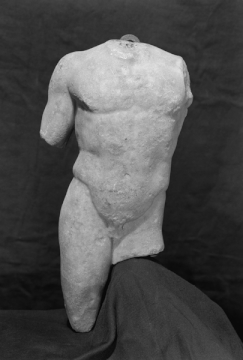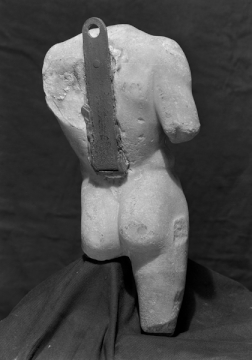Explore Collections


You are here:
CollectionsOnline
/
Torso of a statuette of the doryphoros (spear-bearer) after Polykleitos
Browse
Torso of a statuette of the doryphoros (spear-bearer) after Polykleitos
2nd century AD
Pentelic marble
Height: 36cm
Museum number: M1022
On display: Museum South Passage
All spaces are in No. 13 Lincoln's Inn Fields unless identified as in No. 12, Soane's first house.
For tours https://www.soane.org/your-visit
Curatorial note
The torso, part of the right arm, and the right leg to the knee of a small second century AD replica of the Greek fifth century BC original bronze (now lost), known as the Doryphoros, or Spearbearer (c.440 BC), of Polykleitos (or Polyclitus in Latin), the Argive master sculptor of the middle and latter part of the century. This figure was one of his most popular works and was frequently copied either in whole or in part. Polykleitos was said by the ancients to have created the ideal of the well-constructed athletic male type in sculpture and the bronze original of this statue was cited as the ideal expression of his art1. The Soane statuette is a careful replica in miniature of this life-size statue with the notable exception that the post-Hadrianic second century sculptor has introduced a softness which was not present in the original. Among the replicas of the type the closest parallel sizewise is a statuette 65 cm high in the Museo Chiaramonti of the Vatican2. Like the Vatican marble, the Soane statuette is identified by the remains of the arm support at the wrist and that against the right thigh, both common to the marble copies3.
Chronologically the closest example to this statuette is the second of two full-sized replicas in the Uffizi Gallery, Florence4, which, carrying Hadrianic classicism one step toward the softer movement of the early Antonine period, presents a contrast with its neighbour, a cleverly restored copy which can be dated by analogy with triumphal relief portrait types to the Julio-Claudian period5.
1 On the Doryphoros in relation to the career of Polykleitos, see C. Vermeule, Polykleitos,the first in a series of picture books on famous sculptors, Boston, 1969, pp.3-8; also P.E. Arias, Policleto, Florence, 1964, pp.38-39, 48-49, 139-141, etc.; W.G. Moon, Polykleitos, the Doryphoros and Tradition, Madison, 1995; H. von Steuben, Der Kanon des Polyklet: Doryphoros und Amazone, Tübingen, 1973; Polyklet, der Bildhauer der griechischen Plastik, Mainz, 1990 and D. Kreikenboom, Bildwerke nach Polyklet, Berlin, 1990.
2Die Skulpturen des Vaticanischen Museums, Berlin, 1903-08, Vol. I (1903), no, 484, pl. 66.
3 For the chief replicas and their place in the visualisation of the original, see A. Furtwängler, Masterpieces of Greek Sculpture, ed. and trans. E. Sellers, 2 vols, London, 1895, pp. 226-234, esp. p. 228; M. Bieber, Die antiken Skulpturen und Bronzen des königliche Museum Fridericianum in Cassel, Marburg, 1915, p. 9, no.4, pl.X and bibliography; and, more recently, especially C. Anti, "Monumenti Policletei", in Monumenti Antichi, XXVI, 1920, p. 628ff.
4 Führer, p. 27; Anti, no. 3.
5 Uffizi No. 91; Uffizi no. 52; W. Amelung, Führer durch die Antiken in Florenz, Munich, 1897, p. 20ff; Anti, no. 4.
Chronologically the closest example to this statuette is the second of two full-sized replicas in the Uffizi Gallery, Florence4, which, carrying Hadrianic classicism one step toward the softer movement of the early Antonine period, presents a contrast with its neighbour, a cleverly restored copy which can be dated by analogy with triumphal relief portrait types to the Julio-Claudian period5.
1 On the Doryphoros in relation to the career of Polykleitos, see C. Vermeule, Polykleitos,the first in a series of picture books on famous sculptors, Boston, 1969, pp.3-8; also P.E. Arias, Policleto, Florence, 1964, pp.38-39, 48-49, 139-141, etc.; W.G. Moon, Polykleitos, the Doryphoros and Tradition, Madison, 1995; H. von Steuben, Der Kanon des Polyklet: Doryphoros und Amazone, Tübingen, 1973; Polyklet, der Bildhauer der griechischen Plastik, Mainz, 1990 and D. Kreikenboom, Bildwerke nach Polyklet, Berlin, 1990.
2Die Skulpturen des Vaticanischen Museums, Berlin, 1903-08, Vol. I (1903), no, 484, pl. 66.
3 For the chief replicas and their place in the visualisation of the original, see A. Furtwängler, Masterpieces of Greek Sculpture, ed. and trans. E. Sellers, 2 vols, London, 1895, pp. 226-234, esp. p. 228; M. Bieber, Die antiken Skulpturen und Bronzen des königliche Museum Fridericianum in Cassel, Marburg, 1915, p. 9, no.4, pl.X and bibliography; and, more recently, especially C. Anti, "Monumenti Policletei", in Monumenti Antichi, XXVI, 1920, p. 628ff.
4 Führer, p. 27; Anti, no. 3.
5 Uffizi No. 91; Uffizi no. 52; W. Amelung, Führer durch die Antiken in Florenz, Munich, 1897, p. 20ff; Anti, no. 4.
In Soane's collection by 1811 when it is shown in J.M. Gandy's view of the Museum, SM P384 (centre right; side view).
Soane collections online is being continually updated. If you wish to find out more or if you have any further information about this object please contact us: worksofart@soane.org.uk







